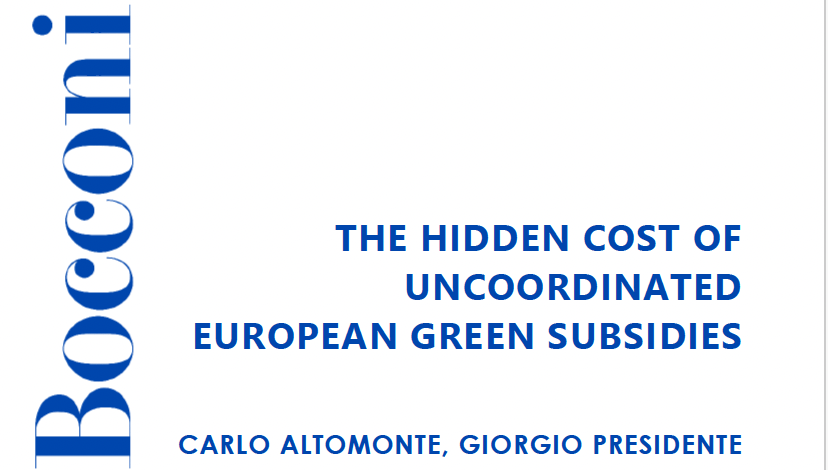Policy Brief n.10 - The Hidden Cost of Uncoordinated European Green Subsidies
This policy brief highlights that while the green subsidies provided by the Inflation Reduction Act of the United States are homogeneous across beneficiaries, the subsidies associated with the Green Deal industrial plan are highly fragmented across European member States. We quantify the extent of resource misallocation due to this subsidy dispersion by using the model of Hsieh and Klenow (2009), calibrated on the EU electricity-producing industry. We compare both the actual allocation of subsidies, and a policy of subsidies coordinated at the EU level, to a hypothetical frictionless benchmark with no subsidies. We find that moving to coordinated subsidies can increase productivity by more than 30% with respect to the uncoordinated scenario, substantially reduce the productivity gap with the United States, and generate gains worth up to 6% of the EU value-added in the industries considered. Policy recommendations include greater EU-level coordination to minimize misallocation and enhance productivity.

• During the last years, although with a different timing, both the European Union (EU) and the United States (US) have committed to reduce greenhouse gas emissions to net-zero levels, that is balancing the amount of emitted greenhouse gases with the amount removed from the atmosphere.
• The key instruments designed to achieve this goal are the Inflation Reduction Act (IRA) in the US, and the Green Deal (GD) initiative in Europe, with an associated industrial plan. Despite sharing similar goals, however, the IRA and the GD are very different initiatives, both in terms of policy instruments and institutional articulation.
• The IRA mainly consists of green subsidies provided through a homogeneous federal tax credit. By contrast, the GD is based on multiple policy instruments—most notably State-aids—and it foresees different levels of intervention (supra-national, national and regional). The inherent complexity is amplified by the fact that member States have already uncoordinated subsidies schemes in place.
• Subsidies are able to address market failures, but they also distort price signals if they are not optimally set, generating inefficiency through resource misallocation. This policy brief abstracts from the environmental impact of the subsidies and focuses on the productivity implications of subsidy dispersion across producers.
• We quantify the extent of resource misallocation due to subsidy dispersion by using the model of Hsieh and Klenow (2009), calibrated on the EU electricity-producing industry in Germany, France, Italy and Spain. In particular, we compare two scenarios: the actual uncoordinated allocation of subsidies over the period considered, and a policy of subsidies coordinated at the EU level. To avoid bias in the comparison, we analyze the two scenarios in terms of difference with respect to a hypothetical frictionless benchmark with no subsidies.
• We find that, with respect to the uncoordinated scenario, moving to coordinated subsidies can increase productivity by roughly 30%. The latter implies that the reform would yield 20 additional euros of value added per hour worked, which translates into 7.86 billion of additional euros accruing to workers in the power sector of Germany, France, Italy and Spain. These gains are worth 2.3% of the power sector gross output and 6.7% of its added value. In terms of productivity gap w.r.t to the US, the subsidy reform would entail productivity gains reducing the EU-US difference from the current 5.4% (at average 2018 exchange rates) to 0.9%, thus closing 83% of the productivity gap. Extending these calculations to the whole industry and energy sectors in the four countries considered, the reform would generate additional income worth around 78 billion euros, or 6.4% of the total value added generated.
• We suggest policy recommendations which would foster a greater EU-level coordination of national existing subsidies so as to minimize misallocation and enhance productivity. Coordination can be implemented by the EU Commission e.g. by leveraging more on Important Projects of Common European Interests. At the same time, a more general provision could be introduced for a ’Single Market of State aids’, based on art. 122 of the Treaty, e.g. through a mechanism of governance consistent with the new EU fiscal governance framework and based on plans of investment and reforms commonly agreed between the EC and the member States, similar to the ones of the Recovery and Resilience Facility.
IEP@BU does not express opinions of its own. The opinions expressed in this publication are those of the authors. Any errors or omissions are the responsibility of the authors.

